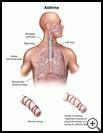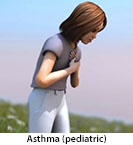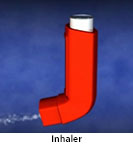
Exercise-Induced Asthma in Children
________________________________________________________________________
KEY POINTS
- Asthma is a long-lasting (chronic) lung disease. Exercise-induced asthma is a form of asthma that causes wheezing, coughing, shortness of breath, or chest tightness during or after physical activity.
- Exercise-induced asthma can be successfully treated with long-term control medicines and quick-relief (rescue) medicines.
- To help prevent exercise-induced asthma, know what triggers your child’s asthma. Wearing a mask or scarf when your child exercises may help protect him from cold, dry air, air pollution, dust, or pollen. Doing warm-up exercises before a workout may help prevent an asthma attack.
________________________________________________________________________
What is exercise-induced asthma?
Asthma is a long-lasting (chronic) lung disease. It causes wheezing, coughing, shortness of breath, and chest tightness. Exercise-induced asthma is a form of asthma that causes problems during or after physical activity.
What is the cause?
Asthma symptoms are caused by two different problems in the airways.
- One problem is that the muscles in the airways tighten up, which causes the feeling of chest tightness and wheezing.
- The other problem is swelling, irritation and too much mucus in the airways.
If your child has asthma, symptoms often start after your child is exposed to a trigger. Asthma triggers can include:
- Exercise (called exercise-induced asthma)
- Allergies, such as dust, pollen, mold, or animal fur
- Something that irritates your child’s lungs, such as cold air, smoke, or strong smells like paint or perfume
- Medicines like aspirin or NSAIDs
- An infection such as a cold, the flu, or a sinus infection
- Strong emotions or stress
- Indigestion, also called gastroesophageal reflux disease, or GERD. If your child often has problems with acid indigestion, he may have more asthma symptoms, especially at night.
In exercise-induced asthma, this can occur:
- During or after physical activity and when breathing is hard, heavy, or fast
- When the air is cold
- When the humidity is very low or high
- When there is a lot of air pollution
- When there are a lot of allergens in the air
For many children, running or riding a bike in the cold air may trigger symptoms. Crying and temper tantrums may also trigger an asthma attack in very young children.
What are the symptoms?
The symptoms of exercise-induced asthma include:
- Wheezing
- Coughing
- Shortness of breath
- Chest tightness
- Fatigue
You may also see that your child does not want to play or do physical activities. Babies may have trouble sucking or feeding.
How is it diagnosed?
Your healthcare provider will ask about breathing problems during or after exercise. He or she may ask you to run on a treadmill to see if you are wheezing after the exercise.
You may do special breathing tests before and after exercise. These tests measure how fast you can exhale air in one breath.
How is it treated?
Exercise-induced asthma can be successfully treated with medicine. Two kinds of asthma medicines may be used.
- Long-term control medicines, also called controller medicines. By taking this medicine regularly every day, it helps to control your child’s symptoms. Your child will take these medicines every day, even if he is not having symptoms. They do not provide quick relief of wheezing in acute asthma attacks.
- Quick-relief medicines, also called reliever, or rescue medicines. These medicines are used as needed to treat exercise-induced asthma attacks. They are not used on a regular, daily basis to prevent asthma symptoms. A quick relief inhaler works fast to relax the muscles of the airways. This kind of medicine is usually given 15 to 30 minutes before exercise. It can prevent symptoms in people with exercise-induced asthma.
How can I take care of my child?
If your child has exercise-induced asthma, let coaches and teachers, who supervise your child know what to do to help your child.
Your child does not need to avoid all exercise and other physical activities. Doing warm-up exercises before a vigorous workout may help prevent an asthma attack.
Some children have more symptoms during strenuous activity in cold, dry air. During the winter, your child may need to exercise indoors or wear a mask when exercising outside. Wearing a mask or scarf warms the air before your child inhales it. You may also need to be aware of conditions such as air pollution or allergens such as dust or pollen.
Your child can usually avoid symptoms by using a quick-relief medicine 15 to 30 minutes before exercise.
Your child may need a few days to recover from a viral illness. In this case, he may need to avoid gym class or sports for a short time.
If your child regularly has a lot of symptoms even after using a quick-relief medicine, talk with his healthcare provider.
Last modified: 2016-06-27
Last reviewed: 2016-06-27



